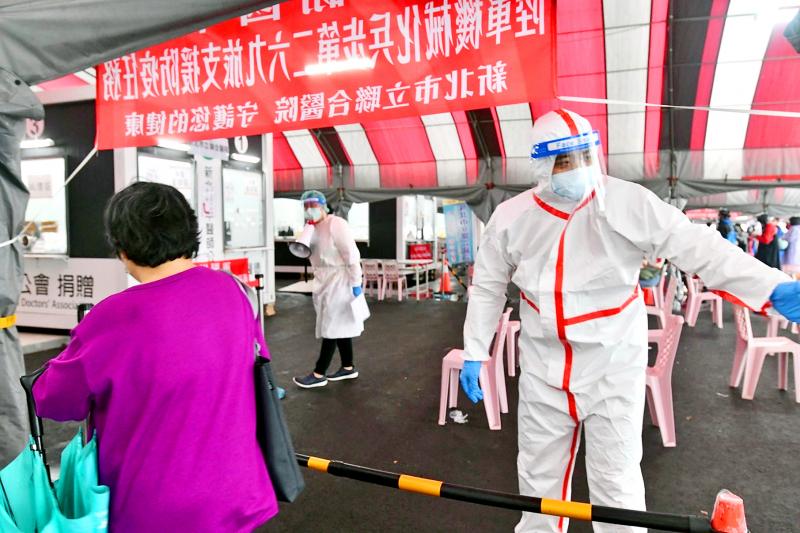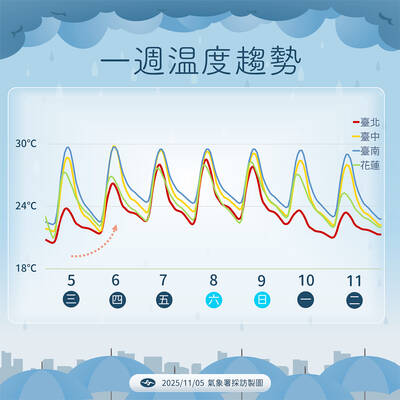The Central Epidemic Command Center (CECC) yesterday announced that the policy of using a positive COVID-19 rapid antigen test result for diagnosis would be expanded to the public starting today, and it reminded the public of the five steps when taking a positive test result to a doctor for assessment.
Minister of Health and Welfare Chen Shih-chung (陳時中), who heads the center, said the policy would be officially expanded to everybody, starting today, and the case definition for COVID-19 had been revised accordingly.
Centers for Disease Control (CDC) Deputy Director-General Chuang Jen-hsiang (莊人祥), who is the CECC spokesman, said the previous case definition was being tested positive in one of two testing methods — a polymerase chain reaction (PCR) test or a rapid antigen test assessed by a doctor — but the eligibility for diagnosis based on the rapid test result was limited to people in home quarantine, home isolation, self-disease prevention, people aged 65 years or older, and residents of indigenous areas and outlying islands.

Photo courtesy of the New Taipei City Department of Health via CNA
Starting today, the definition has been revised to include people who test positive with a rapid antigen test without regard to age or ethnicity, who can be diagnosed as a confirmed case after a doctor confirms the test result, or if the positive rapid test result was performed by a health worker, he said.
The positive test result could be assessed by a doctor through a telemedicine appointment or taken to a doctor at a community testing station or healthcare facility, he said, adding that people who tested positive should remember the following five steps:
They should write their name and testing date on the rapid test cassette with the positive result, put their National Health Insurance (NHI) card next to the cassette and take a photograph, then put the cassette in a bag and take it to a healthcare facility or testing station if they wish to see a doctor in person, he said.
They should wear a mask throughout the visit and are prohibited from taking public transport, but can drive, walk or have a family member drive them to the hospital, Chuang said, adding that those who book a telemedicine appointment should follow the doctor’s instructions.
Chuang said the criteria for getting a PCR test has also been updated in response to the new policy, including when a health provider has doubts about the result of a rapid test performed by them, and when a patient and doctor cannot agree on the result of a rapid test performed by the patient.
They also include when a confirmed case diagnosed based on a rapid test needs to be hospitalized during at-home care; when a patient tests negative with a rapid test, but the doctor suspects the patient to be infected; and when a frontline health worker tests positive with a rapid test and needs to confirm the result with a PCR test within 24 hours, he said.
As the new testing policy has just been implemented, testing stations will continue to offer PCR tests for people who have tested positive with a rapid test, he added.
Deputy Minister of Health and Welfare Shih Chung-liang (石崇良) said the new policy was not immediately adopted when the local outbreak started last month, as about 15 percent of people who tested positive with a rapid test later tested negative in a PCR test at that time.
Placing false-positive cases in isolation or administering unnecessary treatment would have breached the principles of law and ethics, Shih said.
Consistency between rapid test and PCR test results has greatly increased since then to as high as 97 percent in New Taipei City, 93 percent in Taipei and 95 percent in Taichung, meaning the risk of false-negative cases is much lower, he said.
Moreover, after consulting with specialists and local governments, the case definition for COVID-19 has been revised to solve a legal issue, he said, adding that the model of diagnosis through shared decisionmaking between the patient and a doctor would solve the previous ethical issue.

Three Taiwanese airlines have prohibited passengers from packing Bluetooth earbuds and their charger cases in checked luggage. EVA Air and Uni Air said that Bluetooth earbuds and charger cases are categorized as portable electronic devices, which should be switched off if they are placed in checked luggage based on international aviation safety regulations. They must not be in standby or sleep mode. However, as charging would continue when earbuds are placed in the charger cases, which would contravene international aviation regulations, their cases must be carried as hand luggage, they said. Tigerair Taiwan said that earbud charger cases are equipped

Foreign travelers entering Taiwan on a short layover via Taiwan Taoyuan International Airport are receiving NT$600 gift vouchers from yesterday, the Tourism Administration said, adding that it hopes the incentive would boost tourism consumption at the airport. The program, which allows travelers holding non-Taiwan passports who enter the country during a layover of up to 24 hours to claim a voucher, aims to promote attractions at the airport, the agency said in a statement on Friday. To participate, travelers must sign up on the campaign Web site, the agency said. They can then present their passport and boarding pass for their connecting international

UNILATERAL MOVES: Officials have raised concerns that Beijing could try to exert economic control over Kinmen in a key development plan next year The Civil Aviation Administration (CAA) yesterday said that China has so far failed to provide any information about a new airport expected to open next year that is less than 10km from a Taiwanese airport, raising flight safety concerns. Xiamen Xiangan International Airport is only about 3km at its closest point from the islands in Kinmen County — the scene of on-off fighting during the Cold War — and construction work can be seen and heard clearly from the Taiwan side. In a written statement sent to Reuters, the CAA said that airports close to each other need detailed advanced

UNKNOWN TRAJECTORY: The storm could move in four possible directions, with the fourth option considered the most threatening to Taiwan, meteorologist Lin De-en said A soon-to-be-formed tropical storm east of the Philippines could begin affecting Taiwan on Wednesday next week, the Central Weather Administration (CWA) said yesterday. The storm, to be named Fung-wong (鳳凰), is forecast to approach Taiwan on Tuesday next week and could begin affecting the weather in Taiwan on Wednesday, CWA forecaster Huang En-hung (黃恩鴻) said, adding that its impact might be amplified by the combined effect with the northeast monsoon. As of 2pm yesterday, the system’s center was 2,800km southeast of Oluanbi (鵝鑾鼻). It was moving northwest at 18kph. Meteorologist Lin De-en (林得恩) on Facebook yesterday wrote that the would-be storm is surrounded by